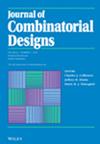求助PDF
{"title":"将有序三元组划分为均匀有序的洞穴设计","authors":"Yuli Tan, Junling Zhou","doi":"10.1002/jcd.21933","DOIUrl":null,"url":null,"abstract":"<p>A large set <math>\n <semantics>\n <mrow>\n <mtext>LOD</mtext>\n <mrow>\n <mo>(</mo>\n <mi>v</mi>\n <mo>)</mo>\n </mrow>\n </mrow>\n <annotation> $\\text{LOD}(v)$</annotation>\n </semantics></math> is a partition of all ordered triples of a <math>\n <semantics>\n <mrow>\n <mi>v</mi>\n </mrow>\n <annotation> $v$</annotation>\n </semantics></math>-set into <math>\n <semantics>\n <mrow>\n <mi>v</mi>\n <mo>−</mo>\n <mn>2</mn>\n </mrow>\n <annotation> $v-2$</annotation>\n </semantics></math> disjoint ordered designs of order <math>\n <semantics>\n <mrow>\n <mi>v</mi>\n </mrow>\n <annotation> $v$</annotation>\n </semantics></math>. In this paper, we generalize the large set <math>\n <semantics>\n <mrow>\n <mtext>LOD</mtext>\n <mrow>\n <mo>(</mo>\n <mi>v</mi>\n <mo>)</mo>\n </mrow>\n </mrow>\n <annotation> $\\text{LOD}(v)$</annotation>\n </semantics></math> with <math>\n <semantics>\n <mrow>\n <mi>v</mi>\n <mo>=</mo>\n <mi>g</mi>\n <mi>t</mi>\n </mrow>\n <annotation> $v=gt$</annotation>\n </semantics></math> to the notion of <math>\n <semantics>\n <mrow>\n <mtext>POT</mtext>\n <mrow>\n <mo>(</mo>\n <msup>\n <mi>g</mi>\n <mi>t</mi>\n </msup>\n <mo>)</mo>\n </mrow>\n </mrow>\n <annotation> $\\text{POT}({g}^{t})$</annotation>\n </semantics></math>, representing a partition of all ordered triples of a <math>\n <semantics>\n <mrow>\n <mi>g</mi>\n <mi>t</mi>\n </mrow>\n <annotation> $gt$</annotation>\n </semantics></math>-set into disjoint uniform holely ordered designs <math>\n <semantics>\n <mrow>\n <mtext>HOD</mtext>\n <mrow>\n <mo>(</mo>\n <msup>\n <mi>g</mi>\n <mi>t</mi>\n </msup>\n <mo>)</mo>\n </mrow>\n </mrow>\n <annotation> $\\text{HOD}({g}^{t})$</annotation>\n </semantics></math>s. We show that a <math>\n <semantics>\n <mrow>\n <mtext>POT</mtext>\n <mrow>\n <mo>(</mo>\n <msup>\n <mi>g</mi>\n <mi>t</mi>\n </msup>\n <mo>)</mo>\n </mrow>\n </mrow>\n <annotation> $\\text{POT}({g}^{t})$</annotation>\n </semantics></math> exists if and only if <math>\n <semantics>\n <mrow>\n <mi>g</mi>\n <mo>=</mo>\n <mn>1</mn>\n <mo>,</mo>\n <mn>2</mn>\n </mrow>\n <annotation> $g=1,2$</annotation>\n </semantics></math> and <math>\n <semantics>\n <mrow>\n <mi>t</mi>\n <mo>≥</mo>\n <mn>3</mn>\n </mrow>\n <annotation> $t\\ge 3$</annotation>\n </semantics></math>, except for <math>\n <semantics>\n <mrow>\n <mrow>\n <mo>(</mo>\n <mrow>\n <mi>g</mi>\n <mo>,</mo>\n <mi>t</mi>\n </mrow>\n <mo>)</mo>\n </mrow>\n <mo>=</mo>\n <mrow>\n <mo>(</mo>\n <mrow>\n <mn>1</mn>\n <mo>,</mo>\n <mn>6</mn>\n </mrow>\n <mo>)</mo>\n </mrow>\n </mrow>\n <annotation> $(g,t)=(1,6)$</annotation>\n </semantics></math>. Moreover, we study the existence of a <math>\n <semantics>\n <mrow>\n <mtext>POT</mtext>\n <mrow>\n <mo>(</mo>\n <msup>\n <mi>g</mi>\n <mi>t</mi>\n </msup>\n <mo>)</mo>\n </mrow>\n </mrow>\n <annotation> $\\text{POT}({g}^{t})$</annotation>\n </semantics></math> with every member <math>\n <semantics>\n <mrow>\n <mtext>HOD</mtext>\n <mrow>\n <mo>(</mo>\n <msup>\n <mi>g</mi>\n <mi>t</mi>\n </msup>\n <mo>)</mo>\n </mrow>\n </mrow>\n <annotation> $\\text{HOD}({g}^{t})$</annotation>\n </semantics></math> having a kind of resolution. We show that a resolvable <math>\n <semantics>\n <mrow>\n <mtext>POT</mtext>\n <mrow>\n <mo>(</mo>\n <msup>\n <mi>g</mi>\n <mi>t</mi>\n </msup>\n <mo>)</mo>\n </mrow>\n </mrow>\n <annotation> $\\text{POT}({g}^{t})$</annotation>\n </semantics></math> exists if and only if <math>\n <semantics>\n <mrow>\n <mi>g</mi>\n <mo>=</mo>\n <mn>1</mn>\n <mo>,</mo>\n <mn>2</mn>\n </mrow>\n <annotation> $g=1,2$</annotation>\n </semantics></math>, <math>\n <semantics>\n <mrow>\n <mi>t</mi>\n <mo>≥</mo>\n <mn>3</mn>\n </mrow>\n <annotation> $t\\ge 3$</annotation>\n </semantics></math>, <math>\n <semantics>\n <mrow>\n <mrow>\n <mo>(</mo>\n <mrow>\n <mi>g</mi>\n <mo>,</mo>\n <mi>t</mi>\n </mrow>\n <mo>)</mo>\n </mrow>\n <mo>≠</mo>\n <mrow>\n <mo>(</mo>\n <mrow>\n <mn>1</mn>\n <mo>,</mo>\n <mn>6</mn>\n </mrow>\n <mo>)</mo>\n </mrow>\n </mrow>\n <annotation> $(g,t)\\ne (1,6)$</annotation>\n </semantics></math>, with 27 possible exceptions. For almost resolvable <math>\n <semantics>\n <mrow>\n <mtext>POT</mtext>\n <mrow>\n <mo>(</mo>\n <msup>\n <mn>2</mn>\n <mi>t</mi>\n </msup>\n <mo>)</mo>\n </mrow>\n </mrow>\n <annotation> $\\text{POT}({2}^{t})$</annotation>\n </semantics></math>s, we prove the asymptotic existence and present a few infinite families.</p>","PeriodicalId":15389,"journal":{"name":"Journal of Combinatorial Designs","volume":"32 5","pages":"274-293"},"PeriodicalIF":0.8000,"publicationDate":"2024-02-19","publicationTypes":"Journal Article","fieldsOfStudy":null,"isOpenAccess":false,"openAccessPdf":"","citationCount":"0","resultStr":"{\"title\":\"Partition of ordered triples into uniform holey ordered designs\",\"authors\":\"Yuli Tan, Junling Zhou\",\"doi\":\"10.1002/jcd.21933\",\"DOIUrl\":null,\"url\":null,\"abstract\":\"<p>A large set <math>\\n <semantics>\\n <mrow>\\n <mtext>LOD</mtext>\\n <mrow>\\n <mo>(</mo>\\n <mi>v</mi>\\n <mo>)</mo>\\n </mrow>\\n </mrow>\\n <annotation> $\\\\text{LOD}(v)$</annotation>\\n </semantics></math> is a partition of all ordered triples of a <math>\\n <semantics>\\n <mrow>\\n <mi>v</mi>\\n </mrow>\\n <annotation> $v$</annotation>\\n </semantics></math>-set into <math>\\n <semantics>\\n <mrow>\\n <mi>v</mi>\\n <mo>−</mo>\\n <mn>2</mn>\\n </mrow>\\n <annotation> $v-2$</annotation>\\n </semantics></math> disjoint ordered designs of order <math>\\n <semantics>\\n <mrow>\\n <mi>v</mi>\\n </mrow>\\n <annotation> $v$</annotation>\\n </semantics></math>. In this paper, we generalize the large set <math>\\n <semantics>\\n <mrow>\\n <mtext>LOD</mtext>\\n <mrow>\\n <mo>(</mo>\\n <mi>v</mi>\\n <mo>)</mo>\\n </mrow>\\n </mrow>\\n <annotation> $\\\\text{LOD}(v)$</annotation>\\n </semantics></math> with <math>\\n <semantics>\\n <mrow>\\n <mi>v</mi>\\n <mo>=</mo>\\n <mi>g</mi>\\n <mi>t</mi>\\n </mrow>\\n <annotation> $v=gt$</annotation>\\n </semantics></math> to the notion of <math>\\n <semantics>\\n <mrow>\\n <mtext>POT</mtext>\\n <mrow>\\n <mo>(</mo>\\n <msup>\\n <mi>g</mi>\\n <mi>t</mi>\\n </msup>\\n <mo>)</mo>\\n </mrow>\\n </mrow>\\n <annotation> $\\\\text{POT}({g}^{t})$</annotation>\\n </semantics></math>, representing a partition of all ordered triples of a <math>\\n <semantics>\\n <mrow>\\n <mi>g</mi>\\n <mi>t</mi>\\n </mrow>\\n <annotation> $gt$</annotation>\\n </semantics></math>-set into disjoint uniform holely ordered designs <math>\\n <semantics>\\n <mrow>\\n <mtext>HOD</mtext>\\n <mrow>\\n <mo>(</mo>\\n <msup>\\n <mi>g</mi>\\n <mi>t</mi>\\n </msup>\\n <mo>)</mo>\\n </mrow>\\n </mrow>\\n <annotation> $\\\\text{HOD}({g}^{t})$</annotation>\\n </semantics></math>s. We show that a <math>\\n <semantics>\\n <mrow>\\n <mtext>POT</mtext>\\n <mrow>\\n <mo>(</mo>\\n <msup>\\n <mi>g</mi>\\n <mi>t</mi>\\n </msup>\\n <mo>)</mo>\\n </mrow>\\n </mrow>\\n <annotation> $\\\\text{POT}({g}^{t})$</annotation>\\n </semantics></math> exists if and only if <math>\\n <semantics>\\n <mrow>\\n <mi>g</mi>\\n <mo>=</mo>\\n <mn>1</mn>\\n <mo>,</mo>\\n <mn>2</mn>\\n </mrow>\\n <annotation> $g=1,2$</annotation>\\n </semantics></math> and <math>\\n <semantics>\\n <mrow>\\n <mi>t</mi>\\n <mo>≥</mo>\\n <mn>3</mn>\\n </mrow>\\n <annotation> $t\\\\ge 3$</annotation>\\n </semantics></math>, except for <math>\\n <semantics>\\n <mrow>\\n <mrow>\\n <mo>(</mo>\\n <mrow>\\n <mi>g</mi>\\n <mo>,</mo>\\n <mi>t</mi>\\n </mrow>\\n <mo>)</mo>\\n </mrow>\\n <mo>=</mo>\\n <mrow>\\n <mo>(</mo>\\n <mrow>\\n <mn>1</mn>\\n <mo>,</mo>\\n <mn>6</mn>\\n </mrow>\\n <mo>)</mo>\\n </mrow>\\n </mrow>\\n <annotation> $(g,t)=(1,6)$</annotation>\\n </semantics></math>. Moreover, we study the existence of a <math>\\n <semantics>\\n <mrow>\\n <mtext>POT</mtext>\\n <mrow>\\n <mo>(</mo>\\n <msup>\\n <mi>g</mi>\\n <mi>t</mi>\\n </msup>\\n <mo>)</mo>\\n </mrow>\\n </mrow>\\n <annotation> $\\\\text{POT}({g}^{t})$</annotation>\\n </semantics></math> with every member <math>\\n <semantics>\\n <mrow>\\n <mtext>HOD</mtext>\\n <mrow>\\n <mo>(</mo>\\n <msup>\\n <mi>g</mi>\\n <mi>t</mi>\\n </msup>\\n <mo>)</mo>\\n </mrow>\\n </mrow>\\n <annotation> $\\\\text{HOD}({g}^{t})$</annotation>\\n </semantics></math> having a kind of resolution. We show that a resolvable <math>\\n <semantics>\\n <mrow>\\n <mtext>POT</mtext>\\n <mrow>\\n <mo>(</mo>\\n <msup>\\n <mi>g</mi>\\n <mi>t</mi>\\n </msup>\\n <mo>)</mo>\\n </mrow>\\n </mrow>\\n <annotation> $\\\\text{POT}({g}^{t})$</annotation>\\n </semantics></math> exists if and only if <math>\\n <semantics>\\n <mrow>\\n <mi>g</mi>\\n <mo>=</mo>\\n <mn>1</mn>\\n <mo>,</mo>\\n <mn>2</mn>\\n </mrow>\\n <annotation> $g=1,2$</annotation>\\n </semantics></math>, <math>\\n <semantics>\\n <mrow>\\n <mi>t</mi>\\n <mo>≥</mo>\\n <mn>3</mn>\\n </mrow>\\n <annotation> $t\\\\ge 3$</annotation>\\n </semantics></math>, <math>\\n <semantics>\\n <mrow>\\n <mrow>\\n <mo>(</mo>\\n <mrow>\\n <mi>g</mi>\\n <mo>,</mo>\\n <mi>t</mi>\\n </mrow>\\n <mo>)</mo>\\n </mrow>\\n <mo>≠</mo>\\n <mrow>\\n <mo>(</mo>\\n <mrow>\\n <mn>1</mn>\\n <mo>,</mo>\\n <mn>6</mn>\\n </mrow>\\n <mo>)</mo>\\n </mrow>\\n </mrow>\\n <annotation> $(g,t)\\\\ne (1,6)$</annotation>\\n </semantics></math>, with 27 possible exceptions. For almost resolvable <math>\\n <semantics>\\n <mrow>\\n <mtext>POT</mtext>\\n <mrow>\\n <mo>(</mo>\\n <msup>\\n <mn>2</mn>\\n <mi>t</mi>\\n </msup>\\n <mo>)</mo>\\n </mrow>\\n </mrow>\\n <annotation> $\\\\text{POT}({2}^{t})$</annotation>\\n </semantics></math>s, we prove the asymptotic existence and present a few infinite families.</p>\",\"PeriodicalId\":15389,\"journal\":{\"name\":\"Journal of Combinatorial Designs\",\"volume\":\"32 5\",\"pages\":\"274-293\"},\"PeriodicalIF\":0.8000,\"publicationDate\":\"2024-02-19\",\"publicationTypes\":\"Journal Article\",\"fieldsOfStudy\":null,\"isOpenAccess\":false,\"openAccessPdf\":\"\",\"citationCount\":\"0\",\"resultStr\":null,\"platform\":\"Semanticscholar\",\"paperid\":null,\"PeriodicalName\":\"Journal of Combinatorial Designs\",\"FirstCategoryId\":\"100\",\"ListUrlMain\":\"https://onlinelibrary.wiley.com/doi/10.1002/jcd.21933\",\"RegionNum\":4,\"RegionCategory\":\"数学\",\"ArticlePicture\":[],\"TitleCN\":null,\"AbstractTextCN\":null,\"PMCID\":null,\"EPubDate\":\"\",\"PubModel\":\"\",\"JCR\":\"Q3\",\"JCRName\":\"MATHEMATICS\",\"Score\":null,\"Total\":0}","platform":"Semanticscholar","paperid":null,"PeriodicalName":"Journal of Combinatorial Designs","FirstCategoryId":"100","ListUrlMain":"https://onlinelibrary.wiley.com/doi/10.1002/jcd.21933","RegionNum":4,"RegionCategory":"数学","ArticlePicture":[],"TitleCN":null,"AbstractTextCN":null,"PMCID":null,"EPubDate":"","PubModel":"","JCR":"Q3","JCRName":"MATHEMATICS","Score":null,"Total":0}
引用次数: 0
引用
批量引用

 求助内容:
求助内容: 应助结果提醒方式:
应助结果提醒方式:


